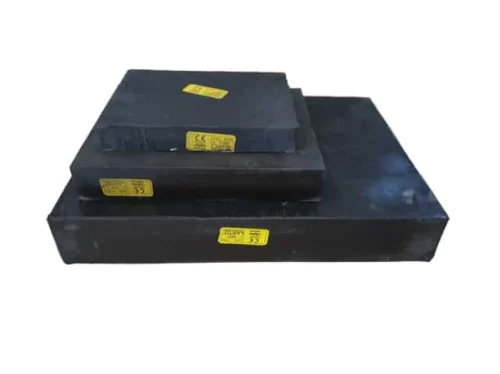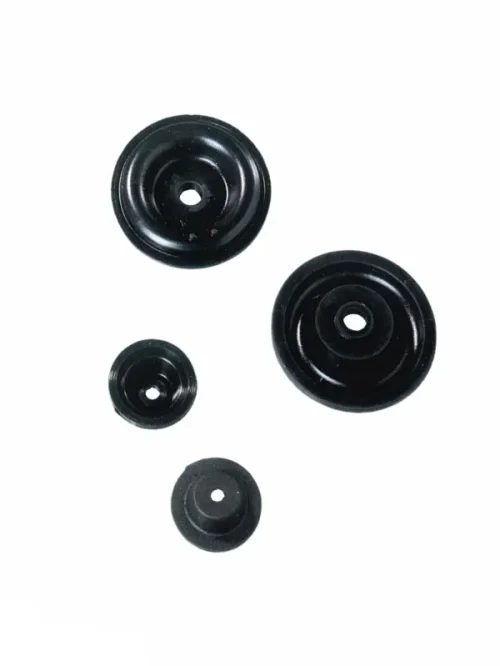Elastomeric and sliding bearings
Dilation of construction concrete structures, in other words bridge bearings reinforced with sheet metal or sliding bearings with a PTFE layer.

PRODUCT DESCRIPTION
Description and use
Elastomer bearings
Rubber bridge bearings used in construction today are sophisticated products made of the highest quality materials. Elastomer bearings are constructed in layers and produced in powerful presses. They are composed of CR (chloroprene rubber) or NR (natural rubber) according to the required standard and steel plates between these rubber layers. According to the requirements of the projects or the requirements of our customers, we can produce elastomeric bearings of cylindrical, square or rectangular shape. We design our elastomer bearings according to the latest knowledge and technical developments in the field of bearing technology. In addition to high-quality rubber, they are also based on metal sheets, the quality of which is also determined based on the relevant standard or customer requirements. These materials stacked on top of each other in the mold are joined by a high-pressure press-joining process called vulcanization. In this way, the rubber adheres to the metal depending on the applied pressure and force.
Sliding bearings with PTFE plates
Sliding-sliding bearings play a very effective role in point solutions of the structure used. Sliding bearings with Teflon plates are used when dealing with tall details that do not have small horizontal displacements except for vertical loads.
Properties
Elastomer bearings
MAJK bridge bearings are subject to quality control before and after production in accordance with European standards. Elastomeric bearings can be manufactured in accordance with AASHTO M251, EN 1337, BS 5400, DIN 4141, TS-ISO 6446 and AS 5100-4 depending on our customers’ requirements.
Sliding bearings with PTFE plates
For all sliding bearings with teflon plates need to use steel plates that do not affect displacement. In general, you can find this type of bearing in buildings, shopping malls and on bridges. Horizontal loads never affect this type of bearing. The horizontal load is transferred directly to the oil spaces that occur on the PTFE materials with silicone oil, which can protect its own integrity and also reduce the friction with the stainless steel plate.
Performances
Material basis
Technical documentation
Description and use
Rubber transitions
Rubber transitions are used to join pipes of different sizes or materials and provide a flexible, leak-proof seal. So they are needed to absorb any tension or movement between the tubes, which is how I want the joint to remain secure. Rubber transitions are commonly used in the plumbing, HVAC and automotive industries. They are made of high-quality rubber materials to ensure their long life and resistance to chemicals and temperature changes.
Membranes
Diaphragms are flexible rubber parts used as baffles in pumps or valves. They are responsible for controlling the flow of liquid and ensure that the liquid flows only in the desired direction. Membranes are an essential part of liquid handling systems and are used in many industries including the medical, chemical and food industries. Materials used in diaphragms are carefully selected to ensure compatibility with the fluids they handle, wear resistance or meet specific standards.
CouplingsCouplings are used to connect two shafts, allowing torque to be transmitted while accommodating misalignment. Commonly used in machinery and power transmission systems, they are designed to fully accommodate axial, radial or angular misalignment between shafts. Couplings are manufactured from high quality rubber materials to ensure that it meets the demands of high speed and high torque applications.
Legs
Feet are rubber components used as shock absorbers or to provide stability devices. They are used to isolate the equipment from vibrations and shocks that may occur during operation, ensuring its smooth and efficient operation. Feet are used in a wide range of applications including electronic equipment, medical devices and industrial machinery. They are made from high-quality rubber materials to ensure their long-term protection and resistance to environmental influences.
Tubes, lids and suction cups
Tubes and additions are also made of rubber and are used in various applications. Tubes are used for sealing, damping and insulation, while covers are used to protect equipment and components. Suction cups are used to grip, lift and manipulate materials. All three components are made of high-quality rubber materials, which lasts a lifetime and is resistant to wear.
Properties
Performances
Material basis
Technical documentation
Rubber grommets, outlets, membranes
Grommets are used to join two pipes of different sizes or materials and provide a flexible, tight seal.
Diaphragms are flexible membranes that are used as baffles in pumps or valves to control fluid flow.
Couplings are used to connect two shafts, allowing torque to be transmitted while accommodating misalignment.
The feet are rubber components used as shock absorbers or to ensure the stability of the device.
Tubes, covers and suction cups are also made of rubber and are used for a variety of applications including sealing, cushioning and gripping.

PRODUCT DESCRIPTION
Description and use
Rubber transitions
Rubber transitions are used to join pipes of different sizes or materials and provide a flexible, leak-proof seal. So they are needed to absorb any tension or movement between the tubes, which is how I want the joint to remain secure. Rubber transitions are commonly used in the plumbing, HVAC and automotive industries. They are made of high-quality rubber materials to ensure their long life and resistance to chemicals and temperature changes.
Membranes
Diaphragms are flexible rubber parts used as baffles in pumps or valves. They are responsible for controlling the flow of liquid and ensure that the liquid flows only in the desired direction. Membranes are an essential part of liquid handling systems and are used in many industries including the medical, chemical and food industries. Materials used in diaphragms are carefully selected to ensure compatibility with the fluids they handle, wear resistance or meet specific standards.
CouplingsCouplings are used to connect two shafts, allowing torque to be transmitted while accommodating misalignment. Commonly used in machinery and power transmission systems, they are designed to fully accommodate axial, radial or angular misalignment between shafts. Couplings are manufactured from high quality rubber materials to ensure that it meets the demands of high speed and high torque applications.
Legs
Feet are rubber components used as shock absorbers or to provide stability devices. They are used to isolate the equipment from vibrations and shocks that may occur during operation, ensuring its smooth and efficient operation. Feet are used in a wide range of applications including electronic equipment, medical devices and industrial machinery. They are made from high-quality rubber materials to ensure their long-term protection and resistance to environmental influences.
Tubes, lids and suction cups
Tubes and additions are also made of rubber and are used in various applications. Tubes are used for sealing, damping and insulation, while covers are used to protect equipment and components. Suction cups are used to grip, lift and manipulate materials. All three components are made of high-quality rubber materials, which lasts a lifetime and is resistant to wear.
Properties
Performances
Material basis
Technical documentation
Description and use
Rubber transitions
Rubber transitions are used to join pipes of different sizes or materials and provide a flexible, leak-proof seal. So they are needed to absorb any tension or movement between the tubes, which is how I want the joint to remain secure. Rubber transitions are commonly used in the plumbing, HVAC and automotive industries. They are made of high-quality rubber materials to ensure their long life and resistance to chemicals and temperature changes.
Membranes
Diaphragms are flexible rubber parts used as baffles in pumps or valves. They are responsible for controlling the flow of liquid and ensure that the liquid flows only in the desired direction. Membranes are an essential part of liquid handling systems and are used in many industries including the medical, chemical and food industries. Materials used in diaphragms are carefully selected to ensure compatibility with the fluids they handle, wear resistance or meet specific standards.
CouplingsCouplings are used to connect two shafts, allowing torque to be transmitted while accommodating misalignment. Commonly used in machinery and power transmission systems, they are designed to fully accommodate axial, radial or angular misalignment between shafts. Couplings are manufactured from high quality rubber materials to ensure that it meets the demands of high speed and high torque applications.
Legs
Feet are rubber components used as shock absorbers or to provide stability devices. They are used to isolate the equipment from vibrations and shocks that may occur during operation, ensuring its smooth and efficient operation. Feet are used in a wide range of applications including electronic equipment, medical devices and industrial machinery. They are made from high-quality rubber materials to ensure their long-term protection and resistance to environmental influences.
Tubes, lids and suction cups
Tubes and additions are also made of rubber and are used in various applications. Tubes are used for sealing, damping and insulation, while covers are used to protect equipment and components. Suction cups are used to grip, lift and manipulate materials. All three components are made of high-quality rubber materials, which lasts a lifetime and is resistant to wear.





